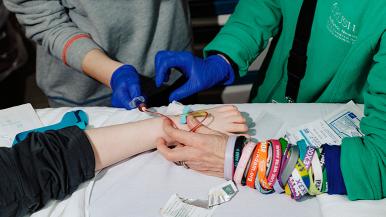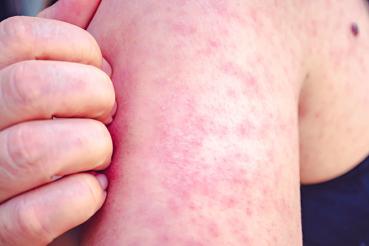Getting the care you need for your child shouldn’t be complicated. But challenges in getting the right care are an unfortunate reality for families who are seeking a diagnosis and treatment for a rare disease.
That was the situation for Matthew and Leigh Sims. Their son Charlie started showing subtle behavioral changes when he was 4 years old. At first, they thought it might be ADHD, but as his symptoms progressed and ADHD was ruled out, the couple found themselves ever deeper down a medical rabbit hole — visiting various specialists, trying to find answers. All the while, they were seeing more changes and even regression in Charlie.
“For so long, all we wanted was a diagnosis. If only we knew what the problem was, then we could start working on a solution,” Matthew said.
Ultimately, they ended up seeking care at RUSH, where their healthcare team started ruling out potential diagnoses to narrow the search. With help from pediatric neurologist Charles Marcuccilli, MD, PhD, developmental pediatrician Marilyn Featherston, DO, and sleep medicine specialist Pallavi Patwari, MD, the Sims family pushed forward with genetic testing for Charlie.
With the genetic testing results pending for months, Charlie was getting worse. He was forgetting things that had recently happened, struggling to ride a bike, and starting to have trouble in school. Charlie’s parents told their physician team that it felt like Charlie was slipping through their fingers. Patwari recognized the family’s desperation and knew they needed to act faster to get an answer.
“She was so profoundly concerned. Even though she was being consulted for Charlie’s sleep problems and had not been the one who ordered the genetic testing, she advocated for us and accelerated the process,” Matthew said. “She said that Charlie’s situation could be one where time really matters, and if it is, we’d need to know as soon as possible.”
Soon after their conversation with Patwari, the couple received the call from Marcuccilli they were waiting for — a diagnosis. But the news they received came as a complete shock — and would forever change their family. Charlie, now 6 years old, had an ultra-rare genetic disorder called CLN1 disease — a form of Batten disease. Described as “a relentless progressive devastating neurodegenerative disorder,” the Simses found out soon after that CLN1 disease had no cure, no approved treatment and had always proven fatal.
“For any parent to receive a diagnosis of this kind is absolutely unimaginable,” Leigh said.
Time is neurons: Paving a path to treatment
Despite a devastating diagnosis, they were determined to use this new information to get their son the help he needed. The family was able to get in quickly with Elizabeth Berry-Kravis, MD, PhD, a leader in advancing treatments for rare pediatric genetic diseases and a pediatric neurologist at RUSH. Looking back, Leigh said getting to this point felt like it came together through a combination of serendipity, divine intervention and persistent strong will to expedite his care.
The family went into their initial appointment armed with all the literature they could find about CLN1 disease, which included information about a proposed gene therapy for Charlie’s rare disease. At the time, the therapy, developed by Taysha Gene Therapies, Inc., was slated for a clinical trial in Canada but was ultimately halted. Because a clinical trial was previously scheduled, some doses of the therapy already had been manufactured. Matthew and Leigh wanted to know what they could do to get Charlie one of those doses.
“We were ready to do whatever it took. If there was this gene therapy that had been made for this disease, and it was actually sitting on a shelf somewhere, why wasn’t it being used to help kids like our son who needed it?” Matthew said. “What a loss for humanity it would be if it just sat there not doing any good to help the very children it had been specifically designed to help.”
In an instance of sheer coincidence, Berry-Kravis already had been scheduled to talk with Taysha representatives just days after her appointment with the Sims family. With the support of RUSH and an agreement from Taysha to provide the gene therapy, Berry-Kravis was able to apply for a special expanded access study with the FDA where Charlie would be the only participant. The “N-of-1” study would allow the drug to be infused into Charlie’s central nervous system with Taysha providing the therapeutic at no cost.
“Dr. Berry-Kravis managed our expectations on how long it would take for the study to be approved, but she warned us and said, ‘Time is neurons.’ For every day that went by without treatment, there would be more neural compromise for Charlie," Matthew said. "We found ourselves in the most important race of our lives, it was a race for our son.”
In September 2023, the FDA granted approval for RUSH to initiate the study. A month later, Charlie became the first human to receive the therapy — three years after the family originally sought answers.
For now, the one-time gene therapy seems to be doing what it is intended to do, which is give Charlie’s neurons the ability to self-produce the deficient PPT1 enzyme in the hopes of slowing down his disease progression. Once-deficient PPT1 enzyme levels in Charlie’s blood have soared exponentially, now measuring within normal limits. But it will take more time before doctors can fully evaluate the effect of the treatment.
Policy problems impact patient care
The quest to develop a gene therapy for CLN1 disease started well over a decade ago, and funding for its development was largely available because of Sharon King and her family’s foundation, Taylor’s Tale. In 2006, when King’s daughter Taylor was 7 years old, she too was diagnosed with CLN1 disease. The family formed Taylor’s Tale to fundraise for more research into treatments and — hopefully one day — a cure. Taylor passed away in 2018 before a therapy could be developed to save her, but her family continued to fight for others in their position.
“‘Rare’ is such a misnomer,” King said. “People say, ‘It doesn’t happen very often,’ but collectively, it happens more than we want to think about. There are 400 million people worldwide with rare diseases. We hide behind the word ‘rare’ — but rare is not so rare when nearly 1 in 20 people are impacted.”
Regulatory issues and red tape are major issues in getting families access to therapies that could help slow or cure diseases. It’s something Berry-Kravis is concerned about.
“I think there will be a crisis because we have such an explosion in diagnoses and treatments to target those diagnoses. But we don’t have a path to get the treatments being developed to people who need them,” Berry-Kravis said.
And while the research continues, clearing the path for approval for these therapies is lagging.
“Science and regulatory issues are separate. We need to see change because if we can’t figure out how to create better regulatory pathways for these conditions, we are going to leave a whole population of patients and families behind. And leave them just like my daughter — with nothing,” King said.
A lag in regulatory approval also could slow down collaboration and potential headway on finding treatments and cures for other more prevalent diseases like cancer.
“As we do research on these therapies, we’re going to start to understand what kind of diseases we can fix,” Berry-Kravis said. “Right now, we’d only give genetic therapies to someone with a very serious illness, but with all the cumulative experience and research in rare diseases, we might find something is safe and we could treat more common diseases with a similar type of therapy. We can build a database of knowledge so that we have the opportunity to improve the quality of life for many.”
Families like the Simses and the Kings are devoted to trying to provide answers and solutions for families with loved ones who have rare diseases. They hope earlier detection and diagnosis will become the norm.
“Families know what they’re up against, and for many of the ultra-rare diseases, it’s universally fatal,” King said. “But families want to contribute. How can you develop treatments with the highest potential of success for patients if you can’t reach them at the right time?”
Hope is an action word
“To say what we have experienced while advocating for our child’s life in the past year has been overwhelming is an incredible understatement,” said Leigh. “While navigating our diagnostic journey I was shocked at the pediatric specialty care waitlists falling between 9 and 36 months — particularly with a disease like Charlie’s where timing is everything.
“Charlie shines a light that fills every heart he touches with sheer joy,” Leigh added. “He has always been extraordinary in his abilities, and considering this shift in our lives, he continues to prove himself as extraordinary. Despite the changes his body has resiliently endured from this disease process, he continues to dance, laugh, play, and love with his whole self. Charlie has bravely fought and will continue to fight this disease while smiling. Our wish is for Charlie’s story to inspire the world to spread love, empathy and, most of all, hope for those who are searching for treatment.”




